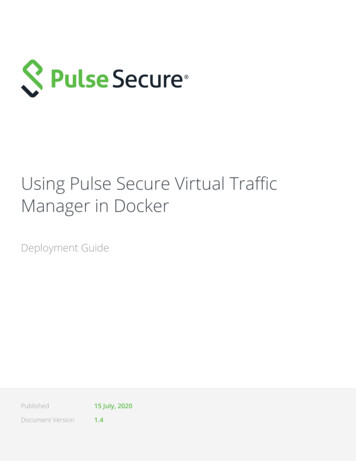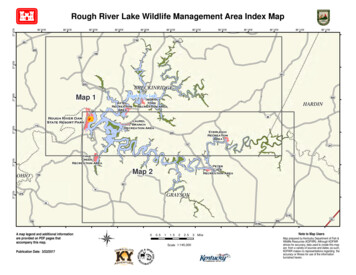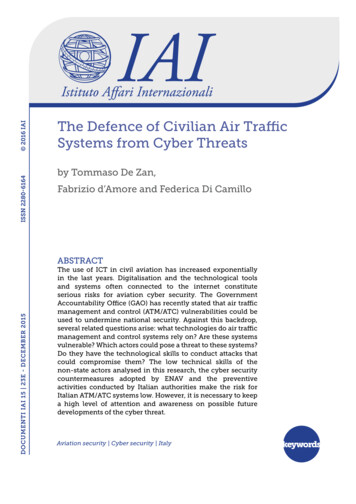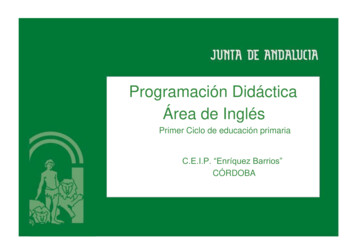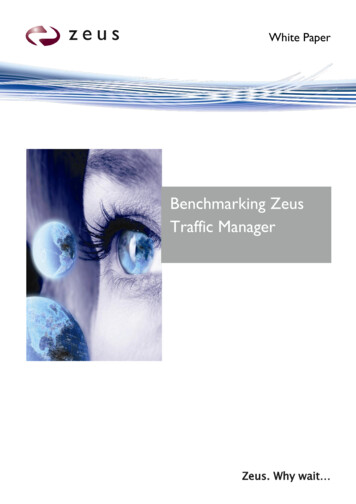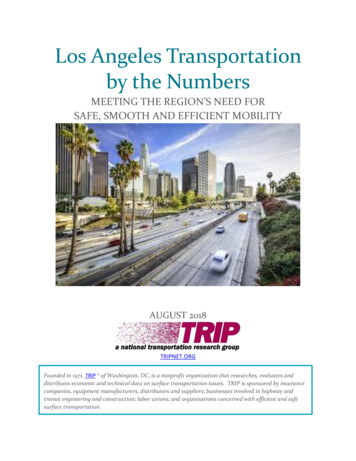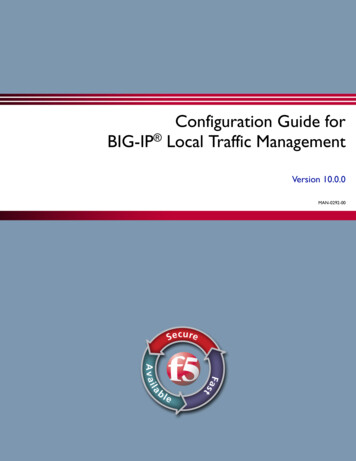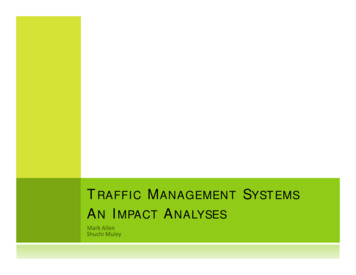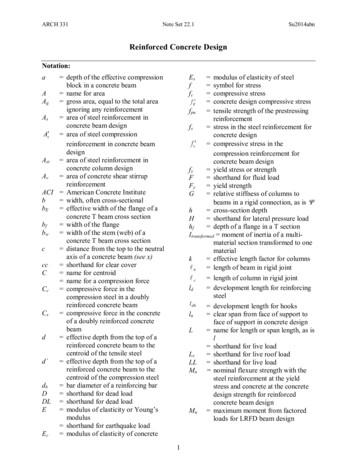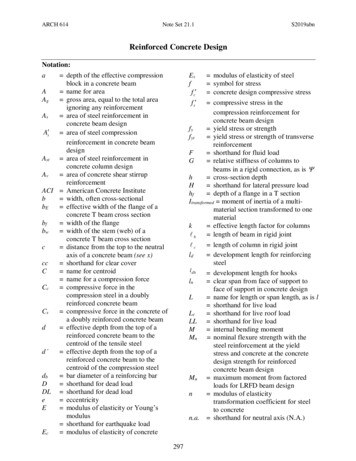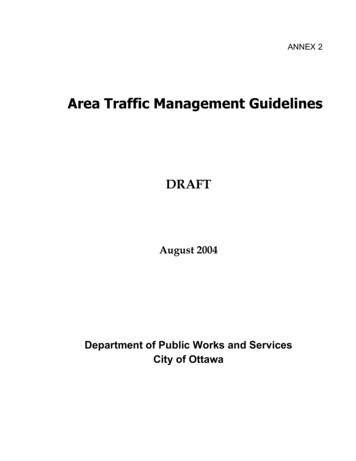
Transcription
ANNEX 2Area Traffic Management GuidelinesDRAFTAugust 2004Department of Public Works and ServicesCity of Ottawa
Area Traffic Management GuidelinesDraft Final ReportCity of OttawaArea Traffic Management GuidelinesACKNOWLEGEMENTSPROJECT TEAMStaff Project Manager:Bob Streicher, Program Manager - Area Traffic ManagementStaff Project Members:Rob Orchin, Manager – Mobility and Area Traffic ManagementMike Flainek, Director – Traffic and Parking OperationsProject Consultants:Rob McCallum, Project Manager, McCormick Rankin CorporationDaniel Haufschild, Deputy Project Manager, McCormick Rankin CorporationKim Hunton, Project Staff, McCormick Rankin CorporationKen Gosselin, Project Advisor, McCormick Rankin CorporationGeoff Noxon, Project Advisor, Noxon AssociatesHoward Williamson, Consultation, Williamson ConsultingRon Jack, Project Advisor, DelcanGerry Forbes, Project Advisor, IntusPUBLIC ADVISORY COMMITTEE: (as approved by Council)David Seabourn, Resident Representative, CentralRichard Mahoney, Resident Representative, CentralRick Findlay, Resident Representative, CentralSteven Agulnik, Resident Representative, CentralElizabeth LeBrun, Resident Representative, CentralAlan Perks, Resident Representative, Suburban EastDaniel Moorcroft, Resident Representative, Suburban WestClarke Bellinger, Resident Representative, Suburban SouthShad Qadri, Resident Representative, RuralChristine Leadman, Business RepresentativeJantine Van Kregten, Business RepresentativePeter McNichol, Cycling Advisory CommitteeScott Clark, Transportation Advisory CommitteeP. Ghosh, Ottawa Youth CabinetTECHNICAL ADVISORY COMMITTEE:Perry McConnell, Fire ServicesMiles Cassidy, Emergency Medical ServicesRick Wilhelm, Ottawa PoliceMike Wildman, Infrastructure ApprovalsPaul Sauvé, Infrastructure ServicesRick Zarzosa, Transit ServicesJohannes Honshorst, Surface OperationsKaren Bays, Public Health and Long Term CareiiAugust 2004
Area Traffic Management GuidelinesDraft Final ReportCity of OttawaArea Traffic Management GuidelinesTable of ContentsAPPENDICESVVIILIST OF EXHIBITS1.INTRODUCTION1WHATISNEEDFORROLEOF2.AREA TRAFFIC MANAGEMENT PRINCIPLESAREA TRAFFIC MANAGEMENT?1AREA TRAFFIC MANAGEMENT GUIDELINESAREA TRAFFIC MANAGEMENT124COMMUNITY EQUITY4E F F E C T I VE N E S S5EFFICIENCY63.8AREA TRAFFIC MANAGEMENT PROCEDURESP H A S E O N E – P R E -S T U D Y11S T E P O N E – C O N C ER N S R E P O R T E DS T E P T W O – S U B M I SS I O NOFTOCITYREQUEST1113STEP THREE – SCREENING PROCESS16STEP FOUR - CATEGORIZE PROJECTSSTEP FIVE – PRIORITIZATION20O F ST U D I ESPHASE TWO – STUDY STAGE2125STEP SIX – DATA COLLECTION25STEP SEVEN - IDENTIFY STAKEHOLDERSSTEP EIGHT - PROJECT KICK-OFF MEETING2931S T E P N I N E - N E I G H B O U R H O O D W O R K SH O P(C O M P R E H E N S I V E S T U D Y O N L Y - O P T I O N A L )STEP TEN - DEVELOP ALTERNATIVE SOLUTIONSiii3537August 2004
Area Traffic Management GuidelinesDraft Final ReportCity of OttawaArea Traffic Management GuidelinesS T E P E L EV E N – A N A L Y Z EANDEVALUATE ALTERNATIVES38STEP TWELVE - PUBLIC OPEN HOUSESTEP THIRTEEN – APPROVALAND41STUDY REPORT43PHASE THREE - IMPLEMENTATION STAGESTEP FOURTEEN - PRIORITIZATIONOFMEASURES44FORIMPLEMENTATION44STEP FIFTEEN - IMPLEMENTATION46S T E P S I X T E E N – M O N I T O R I N G , E V A L U A T I O N , R E V I S I O N /R E M O V A L4.46AREA TRAFFIC MANAGEMENT MEASURES52COMBINING MEASURES53EMERGING MEASURES / PILOT PROJECTS53MEASURES TOOLBOXAPPLICATIONANDLIMITATIONS53OFM E A SU R E Siv54August 2004
Area Traffic Management GuidelinesDraft Final ReportCity of OttawaArea Traffic Management GuidelinesAPPENDICESAPPENDIX A. TRAFFIC MANAGEMENT (VOLUMES) . A-1Directional Closure.A-2Full Closure.A-3Diverters.A-4Forced Turn Island.A-5Right-in/Right-out Island.A-6Median Barriers.A-7Turn and Movement Prohibitions .A-8One-Way Street .A-9Arterial Road Modification .A-10APPENDIX B. TRAFFIC MANAGEMENT (SPEED AND BEHAVIOUR). B-1Speed Zoning.B-2One-Way to Two-Way Street Conversion .B-3On-Street Parking .B-4Pavement Markings .B-5Narrowing of Streets .B-6Realigned Intersection .B-7APPENDIX C. PHYSICAL MEASURES (TRAFFIC CALMING) . C-1Speed Humps/Table . C-2Raised Crosswalks. C-3Raised Intersection . C-4Traffic Circle (Mini). C-5Chicanes . C-6APPENDIX D. PHYSICAL MEASURES (OTHER) . D-1Intersection Narrowings . D-2Mid-Block Narrowings . D-3Centre Island narrowings (Median) . D-4Curb Radii Reduction. D-5Lateral Shift. D-6APPENDIX E. TRANSPORTATION DEMAND MANAGEMENT.E-1Neighbourhood-Based TDM Toolkit.E-2vAugust 2004
Area Traffic Management GuidelinesDraft Final ReportCity of OttawaArea Traffic Management GuidelinesAPPENDIX F. EDUCATION AND ENFORCEMENT .F-1Neighbourhood Speed Watch .F-2Safety and Education Campaigns.F-4Targeted Enforcement .F-5APPENDIX G. STREET ENVIRONMENT . G-1Streetscaping . G2Gateways . G-3Textured Crosswalk . G-4Textured Surfaces. G-5Sidewalks. G-6Woonerf . G-7APPENDIX H. TRAFFIC CONTROL. H-1Stop Signs.H2Modern Roundabouts.H1viAugust 2004
Area Traffic Management GuidelinesDraft Final ReportCity of OttawaArea Traffic Management GuidelinesLIST OF EXHIBITSExhibit 3-1 ATM Process Overview . 10Exhibit 3-2 Sample - Community Traffic Issue Reporting Form (1 of 2 pages). 14Exhibit 3-3 Data Needs - Prioritization. 17Exhibit 3-4 Sample - Screening Checklist. 18Exhibit 3-5 Sample Prioritization Worksheet – Localized Studies. 23Exhibit 3-6 Sample Prioritization Worksheet – Comprehensive Studies. 24Exhibit 3-7 Data Guidelines . 26Exhibit 3-8 Sample Comment Sheet . 33Exhibit 3-9 Sample Sign-in Sheet. 34Exhibit 3-10 Potential Evaluation Factors and Indicators . 40Exhibit 4-1– Measures Application / Impact Matrix. 55viiAugust 2004
Area Traffic Management GuidelinesDraft Final ReportCity of OttawaIntroduction1. I N T R O D U C T I O NWHAT IS AREA TRAFFIC MANAGEMENT?Area Traffic Management (ATM) encompasses a process and a set of measures used toensure that the streets within neighbourhoods are used appropriately. The primary concern isto ensure that the impact of motorized vehicles on these neighbourhoods is minimized, toimprove safety and the quality of life of other street users and those impacted by the use of thestreet.In order to achieve this, a variety of regulatory measures, physical measures, and programscan be used to address such issues as excessive vehicular speed, higher than desired trafficvolumes, and inappropriate driver behaviour. Over the past decade, the term “traffic calming”has become popular in many locations to describe the process of dealing with traffic issues. InOttawa, the City has chosen to use “area traffic management” as the term to describe theprocess of dealing with neighbourhood traffic concerns, and “traffic calming measures” as onespecific set of physical measures (such as speed humps and mini traffic circles) among abroader set of measures that can be used to achieve the desired improvement. The City alsouses other physical measures, regulatory measures (e.g. closures, turning prohibitions), andeducational programs (e.g. neighbourhood speed watch) depending on the nature of theproblem and the range of options.It is important to realize that measures used to address problems typically have secondaryimpacts that can negatively affect some street users or residents. In deciding how to deal withproblems, the expected improvement must be balanced against any such impacts that couldoccur. The net result of any area traffic management initiative should be positive, when allpoints of view are considered.NEED FOR AREA TRAFFIC MANAGEMENT GUIDELINESThe City of Ottawa decided to prepare guidelines for Area Traffic Management due toconcerns over the multitude of approaches that were used by the twelve municipalgovernments before amalgamation in 2001. The new City’s staff and council had been leftwith an assortment of policies and approaches that in some cases were in conflict. Theharmonized approach and consistent set of measures, outlined in these Guidelines will ensurethat the City can move forward and deal with neighbourhood traffic issues in a consistent andunderstandable manner.These Guidelines implement the City of Ottawa’s Official Plan and Transportation Master Planpolicies as they relate to the impact of motorized vehicle traffic on neighbourhoods.1August 2004
Area Traffic Management GuidelinesDraft Final ReportCity of OttawaIntroductionROLE OF AREA TRAFFIC MANAGEMENTIn June 2002, Council approved seven principles to guide the development of its Ottawa 20/20Growth Management Strategy (including the Official Plan and Transportation Master Plan),and to influence subsequent day-to-day decisions.Several of these principles are related to how the City deals with traffic-related issues in itsneighbourhoods:A Caring and Inclusive City calls for safety and security within communitiesA Green and Environmentally-Sensitive City calls for a focus on walking, cyclingand transit, and protection of air, water, earth and other natural resourcesA City of Distinct, Liveable Communities calls for accessibility of facilities bywalking, cycling and transit, ease of mobility within communities, and physical beauty inpublic spacesAn Innovative City Where Prosperity Is Shared Among All calls for a businesssupportive environment, and accessibility to opportunity for individualsA Responsible and Responsive City calls for municipal leadership, fiscalresponsibility, open and participatory processes, community partnerships and publicawarenessTransportation systems play a major part in the creation of liveable neighbourhoods, and caneither help or hinder the achievement of objectives like those listed above. The City’s newOfficial Plan reiterates the need for a balanced transportation system as an integralcomponent of liveable communities. Area traffic management is, however, just one of manydisciplines through which the City will work to bring transportation into balance with othercommunity needs. These include:Public Transit ServicesCommunity Design ProcessesCycling and Walking ProgramsDevelopment ApprovalsTransportation Demand ManagementRoad Safety ProgramsParking ServicesRoad Design StandardsPolice Fire And Paramedic ServicesHealthy Community Initiatives, and,Area Traffic Management.2August 2004
Area Traffic Management GuidelinesDraft Final ReportCity of OttawaIntroductionArea traffic management (ATM) is, therefore, just one of many areas in which the City will workto bring transportation into balance with other community needs.The City’s draftTransportation Master Plan defines Area Traffic Management as follows:“Area traffic management is a term that describes both the processand techniques of preserving neighbourhood liveability by mitigatingundesirable effects of vehicular travel including excessive volumes andspeeds, aggressive driver behaviour and the creation of unfavourableconditions for walking and cycling.”There are three aspects commonly related to the use of motorized vehicles that result inneighbourhood concerns: excessive traffic speeds, excessive traffic volumes (especiallythrough traffic), and inappropriate driver behaviour. These are best examined in terms of theireffects on people: how they impact on personal or public safety, and the effect on theliveability of neighbourhoods.The ATM Guidelines also address a secondary problem related to the process by which areatraffic concerns are dealt with: the lack of any established process results in an inconsistentapproach and inconsistent application of measures, and also does not provide the City withany means to prioritize concerns and deal with the most serious problems.It is important to recognize that area traffic management is primarily an operational processintended to address existing traffic issues deemed to be of a significant nature (i.e. not easilyresolved through an operational review) within neighbourhoods. The ATM Guidelines providestaff with the ability to deal with these significant traffic issues in a consistent manner.3August 2004
Area Traffic Management GuidelinesDraft Final ReportCity of OttawaArea Traffic Management Principles2. A R E A T R A F F I C M A N A G E M E N T P R I N C I P L E SThe City recognizes that the speed, volume and behaviour of motorized vehicles inneighbourhoods are significant concerns of some residents, and that area traffic managementmeasures can improve public safety and liveability. This section recommends a number ofprinciples to guide the area traffic management process. These principles are categorizedaccording to three main governing objectives—community equity, effectiveness andefficiency—and are presented in the following sections.COMMUNITY EQUITYArea traffic management should ensure the equitable and consistent treatment of those whouse Ottawa’s streets, and those who are impacted by that use.Principle 1:Define and follow a consistent process. Citizens have a right to know howtheir concerns will be addressed. Equity requires that area traffic managementprocesses be clearly identified and consistently applied. This does not implythat “one size fits all”, but rather that a sound methodology be followed thattakes into account both the similarities and differences among situations.Principle 2:Do good planning. The City should follow widely accepted “good planning”principles — considering a range of solutions, systematically evaluatingalternatives, consulting with affected stakeholders, and documenting results.The process should be open, thorough, understandable and inclusive.Principle 3:Recognize diverse interests. Ottawa’s streets affect adjacent residents,businesses and institutions, all of who should be considered in makingdecisions on the physical arrangement and regulation of streets. The streetsalso have a multitude of users, both non-motorized (pedestrians, cyclists) andmotorized (cars, trucks, buses, emergency vehicles, maintenance vehicles),whose interests are also critical.Principle 4:Recognize the diverse role of streets: Ottawa’s streets play an importantrole in building our community and serving a transportation function. Thepriority of different interests on a given street will vary according to thecommunity context and street type. Both the context and street type need to beconsidered in order to develop effective solutions to area traffic managementproblems.Community Context: The community context of a street includes considerationof surrounding land uses, the character of the neighbourhood, and how thecommunity uses the street.Street Types: The definition of street types used by the city typically reflectstheir transportation function. They may be considered part of the bicycle,pedestrian or transit network.The City’s Transportation Master Planspecifically defines four street types according to how they address mobility4August 2004
Area Traffic Management GuidelinesDraft Final ReportCity of OttawaArea Traffic Management Principlesand access needs. The four street types are: Arterial Streets, Major CollectorStreet, Collector Streets and Local Streets.Principle 5:Preserve community access. Area traffic management measures shouldconsider the neighbourhood access needs of neighbourhood residents,employees, students, visitors and business patrons.Principle 6:Consult all stakeholders. Community participation and partnerships are anessential component of area traffic management initiatives. They are vital notonly to identify problems, suggest possible solutions, and evaluate thesealternative solutions, but also to build a consensus around the ultimate solutionand assure its long-term success. In addressing neighbourhood traffic issues,the City should engage those who are affected by street activities and thosewho need to use the street. Typical stakeholders include residents, communityassociations, business owners, school administrators, pedestrians, cyclists,drivers, and providers of transit, emergency and maintenance services.Principle 7:Ensure equity of access to resources. The City recognizes that somecommunities may have the desire and ability to invest in their neighbourhoodinfrastructure. However, the City needs to maintain equity among communities,and should address problems (including the allocation of resources to studythese problems) on the basis of need, rather than ability to pay. The Cityshould assume responsibility for funding area traffic management studyprocesses and the development of solutions. However, the City may considercommunity-funding (such as the Local Improvement Act process) to advancethe implementation of measures that have been previously approved and arealready on a priority list for implementation.EFFECTIVENESSArea traffic management should effectively address problems while minimizing or mitigatingany related secondary impacts.Principle 8:Confirm problems objectively. The City needs to maximize its ability tojustify, predict and assess the effectiveness of possible solutions to area trafficmanagement problems. Observation, data collection and analysis shouldprovide an objective determination of the nature and severity of neighbourhoodtraffic concerns. The City recognizes that some liveability concerns are difficultto verify through direct measurement.Principle 9:Use the right tool for the job. Area traffic management initiatives shouldconsider the potential effectiveness of all potential measures in the ATM“toolbox”, and should apply them consistently using accepted Guidelines andstandards.Principle 10: Improve non-auto travel. Measures to reduce the impact of motorizedvehicles on neighbourhoods should also enhance (or at least preserve) thesafety, comfort and convenience of walking, cycling and transit use. Thevarious modes of travel accommodated on Ottawa’s streets may require trade-5August 2004
Area Traffic Management GuidelinesDraft Final ReportCity of OttawaArea Traffic Management Principlesoffs to be made, and the priority given to each mode may vary depending onthe type of street, demand for its use, and the surrounding environment.Principle 11: Solve the problem, don’t move it. The City should avoid measures that diverttraffic to other streets with similar characteristics within a community or anadjacent community (e.g. from one local street to another), or that causeproblems like speeding to develop elsewhere. In some cases it may beappropriate to consider measures that divert traffic to streets that can moreappropriately accommodate the traffic (e.g. arterial streets).Principle 12: Protect the public interest. Protection of the public interest requires that allarea traffic management initiatives meet the same standards of equity,effectiveness and efficiency. To be viewed as credible in the wider community,it is important that area traffic management initiatives be carried out in aconsistent manner, in such a way as to balance the general public interest withthe interests of stakeholders. The City has a responsibility to ensure that thoseleading initiatives balance these interests. Plans brought forward directly by acommunity will be reviewed to ensure conformity with the approved screening,prioritization and threshold requirements of the Area Traffic ManagementGuidelines.Principle 13: Follow up with monitoring and evaluation. The City should monitor areatraffic management measures, evaluate their effectiveness, and make resultsavailable to the community. The evaluation will include recommendations forany required adjustments to the Plan.EFFICIENCYArea traffic management initiatives should aim to achieve the greatest possible benefits withthe available resources.Principle 14: Take a measured approach to solving problems. During the planningstages, the City should consider simple, inexpensive measures before morecomplex and costly ones. This approach can address concerns, whileminimizing the potential for secondary impacts, municipal costs (includingoperations and maintenance), road user costs, vehicle emissions and negativepublic reaction.Principle 15: Prioritize problems and solutions. The order in which the City addressesarea traffic concerns should correspond to the severity of those concerns andthe City’s ability to verify them. Area traffic management measures, onceapproved for implementation, should be prioritized in a manner that usesresources most effectively.Principle 16: Take advantage of opportunities. The City should consider the need andability to incorporate area traffic management measures in all projects involvingroad reconstruction, as an inexpensive way to improve safety and liveability.This consideration should not, however, unreasonably compromise the City’sability to address the highest priority problems, or the following of a “goodplanning” process that is open, thorough, understandable and inclusive. Due to6August 2004
Area Traffic Management GuidelinesDraft Final ReportCity of OttawaArea Traffic Management Principlesthe significant timelines often involved in the planning process within area trafficmanagement, this may only be possible if potential opportunities can beidentified well in advance of their scheduled reconstruction.Principle 17: Don’t create new problems. The City should ensure that new roads andreconstructed roads are laid out and designed to minimize the likelihood offuture area traffic management concerns.7August 2004
Area Traffic Management GuidelinesDraft Final ReportCity of OttawaArea Traffic Management Procedures3. A R E A T R A F F I C M A N A G E M E N T P R O C E D U R E SThe establishment of a focused, consistent Area Traffic Management (ATM) processaddresses two major problems:Inconsistent public expectations — The City’s former constituent municipalitiesemployed diverse terminologies, policies and practices related to area trafficmanagement and traffic calming. A single, harmonized approach is required to “levelthe playing field” in terms of the public’s understanding of how the City will addressthese issues, what tools it is willing to use, and so on.Resource constraints — The City does not have sufficient funds and staff time toaddress every traffic concern that is raised. A process is required to help identify themost serious problems and address them efficiently.This chapter describes procedures that City staff will follow when undertaking Area TrafficManagement (ATM) studies. The procedures are organized in a step-by-step format in threestudy phases: pre-study, study and implementation. A general process overview is providedbelow.For each step, a list of support materials is included, such as a list of data needs or reportingforms. Project file requirements are also listed in order to ensure a consistent approach torecord keeping.It is not always clear at the beginning of an ATM study as to whether the EnvironmentalAssessment (EA) process will need to be followed, as only certain measures are subject to theprocess. The procedures described in this chapter show all studies beginning with theassumption that the EA process applies, and also show a decision point where it is determinedwhether the study needs to conclude under the EA process. Specific project requirements toconform with EA requirements are highlighted. It is particularly important that steps requiredby the EA process are fully documented in the project file.It is expected that almost all ATM studies subject to the EA process will be Schedule “B”projects, as the cost of implementation will usually be less than 1.5 million. The processoutlined assumes this is the case. The following list includes definitions of schedules Athrough C as contained in the Class Environmental Assessment document for municipalprojects.Schedule AGenerally includes normal or emergency operational and maintenance activitiesThe environmental effects of the activities are usually minimal and, therefore, theseprojects are pre-approved.8August 2004
Area Traffic Management GuidelinesDraft Final ReportCity of OttawaArea Traffic Management ProceduresSchedule BGenerally includes improvements and minor expansion
Area Traffic Management Guidelines City of Ottawa Draft Final Report Area Traffic Management Guidelines STEP ELEVEN – ANALYZE AND EVALUATE ALTERNATIVES 38 STEP TWELVE - PUBLIC OPEN HOUSE 41 STEP THIRTEEN – APPROVAL AND STUDY REPORT 43 PHASE THREE - IM

